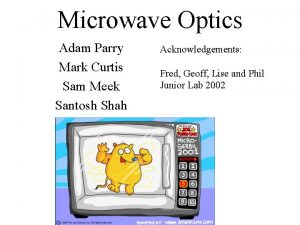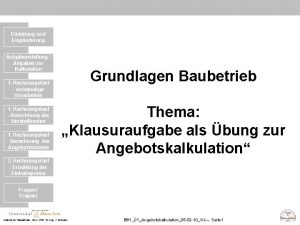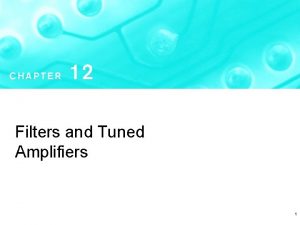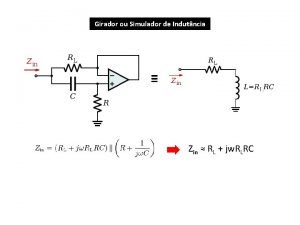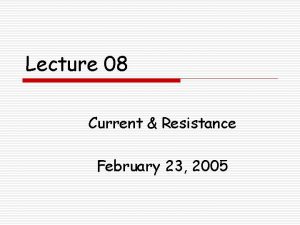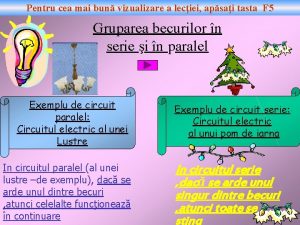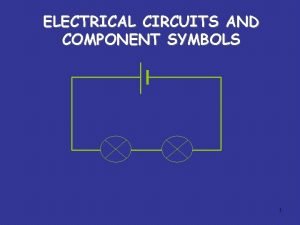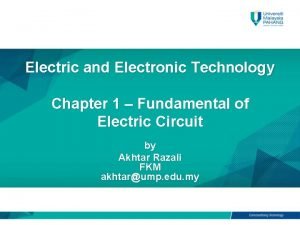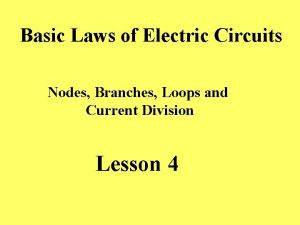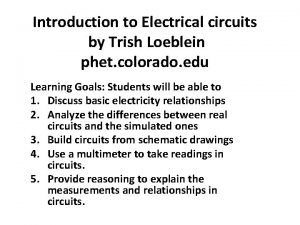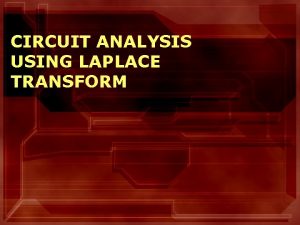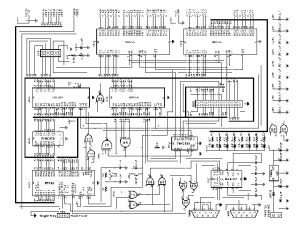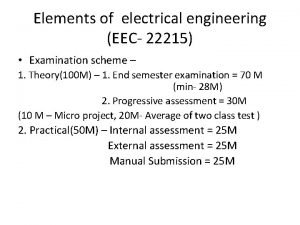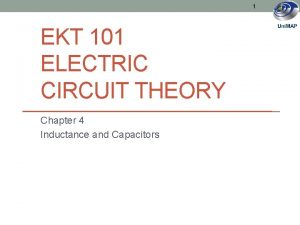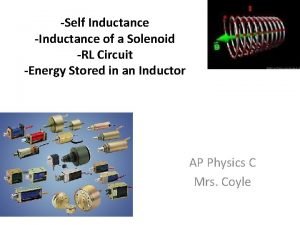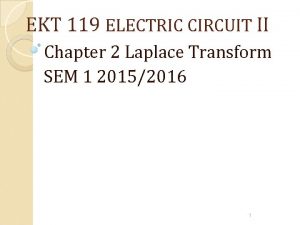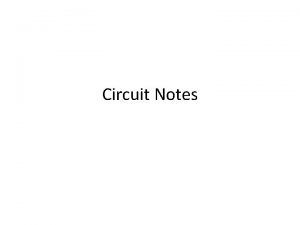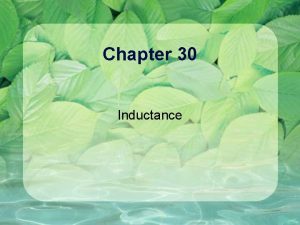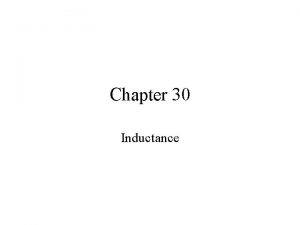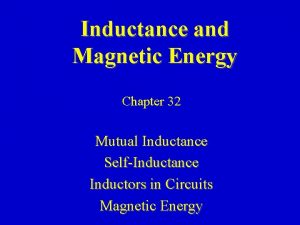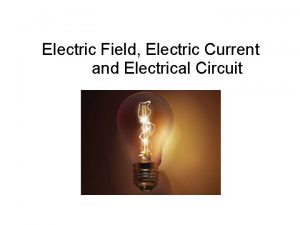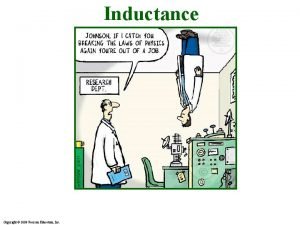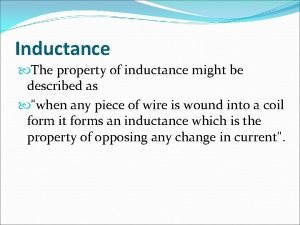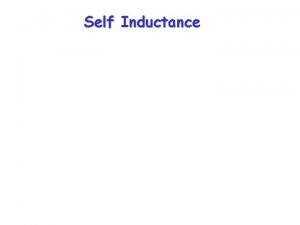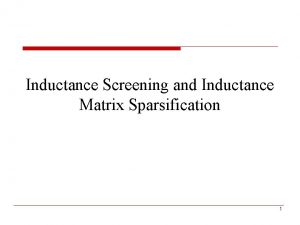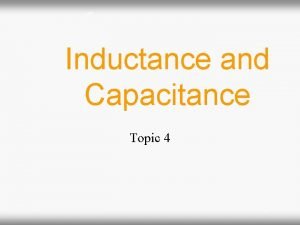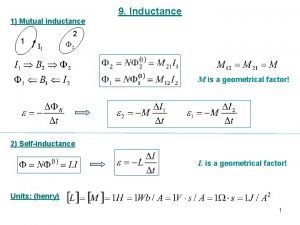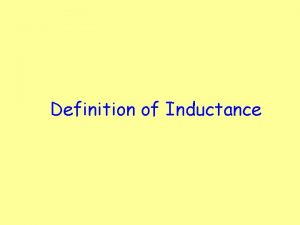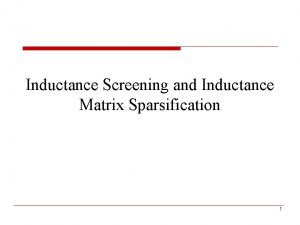EKT 101 Electric Circuit Theory Chapter 4 Inductance























- Slides: 23

EKT 101 Electric Circuit Theory Chapter 4 Inductance and Capacitors 1

Chapter 4 Inductance and Capacitance 4. 1 Inductors 4. 2 Relationship between voltage, current, power and energy of inductor 4. 3 Capacitors 4. 4 Relationship between voltage, current, power and energy of capacitor 4. 5 Combination of inductor and capacitor in series and parallel circuit 2

4. 1 Inductors (1) An inductor is a passive element designed to store energy in its magnetic field. • An inductor consists of a coil of conducting wire. 3

4. 1 Inductors (2) Inductance is the property whereby an inductor exhibits opposition to the change of current flowing through it, measured in henrys (H). and • The unit of inductors is Henry (H), m. H (10– 3) and H (10– 6). 4

4. 2 Relationship between voltage, current, power and energy of inductor The current-voltage relationship of an inductor: • The power stored by an inductor: • An inductor acts like a short circuit to dc (di/dt = 0) and its current cannot change abruptly. 5

4. 2 Relationship between voltage, current, power and energy of inductor Example 5 The terminal voltage of a 2 -H inductor is v = 10(1 -t) V Find the current flowing through it at t = 4 s and the energy stored in it within 0 < t < 4 s. Assume i(0) = 2 A. 6

Answer: i(4 s) = -18 V w(4 s) = 320 J 7

4. 3 Capacitors (1) A capacitor is a passive element designed to store energy in its electric field. • A capacitor consists of two conducting plates separated by an insulator (or dielectric). 8

4. 3 Capacitors (2) Capacitance C is the ratio of the charge q on one plate of a capacitor to the voltage difference v between the two plates, measured in farads (F). and • Where is the permittivity of the dielectric material between the plates, A is the surface area of each plate, d is the distance between the plates. • Unit: F, p. F (10– 12), n. F (10– 9), and F (10– 6) 9

4. 4 Relationship between voltage, current, power and energy of capacitor (1) If i is flowing into the +ve terminal of C Charging => i is +ve Discharging => i is –ve • The current-voltage relationship of capacitor according to above convention is and 10

4. 4 Relationship between voltage, current, power and energy of capacitor (2) The energy, w, stored in the capacitor is • A capacitor is – an open circuit to dc (dv/dt = 0). – its voltage cannot change abruptly. 11

4. 4 Relationship between voltage, current, power and energy of capacitor (3) Example 1 The current through a 100 - F capacitor is i(t) = 50 sin(120 t) m. A. Calculate the voltage across it at t =1 ms and t = 5 ms. Take v(0) =0. Answer: v(1 ms) = 93. 14 m. V v(5 ms) = 1. 7361 V 12

solution 13

4. 4 Relationship between voltage, current, power and energy of capacitor (4) Example 2 An initially uncharged 1 -m. F capacitor has the current shown below across it. Calculate the voltage across it at t = 2 ms and t = 5 ms. Answer: v(2 ms) = 100 m. V v(5 ms) = 500 m. V 14

Series and Parallel Capacitors (1) The equivalent capacitance of N parallel-connected capacitors is the sum of the individual capacitances. 15

Series and Parallel Capacitors (2) The equivalent capacitance of N series-connected capacitors is the reciprocal of the sum of the reciprocals of the individual capacitances. 16

Series and Parallel Capacitors (3) Example 3 Find the equivalent capacitance seen at the terminals of the circuit in the circuit shown below: Answer: Ceq = 40 F 17

Series and Parallel Capacitors (4) Example 4 Find the voltage across each of the capacitors in the circuit shown below: Answer: v 1 = 30 V v 2 = 30 V v 3 = 10 V v 4 = 20 V 18

Series and Parallel Inductors (1) The equivalent inductance of series-connected inductors is the sum of the individual inductances. 19

Series and Parallel Inductors (2) • The equivalent capacitance of parallel inductors is the reciprocal of the sum of the reciprocals of the individual inductances. 20

Series and Parallel Capacitors (3) Example 7 Calculate the equivalent inductance for the inductive ladder network in the circuit shown below: Answer: Leq = 25 m. H 21

Series and Parallel Capacitors (4) Current and voltage relationship for R, L, C + + + 22

4. 5 Combination of inductor and capacitor in series and parallel circuit Example 6 Determine vc, i. L, and the energy stored in the capacitor and inductor in the circuit of circuit shown below under dc conditions. Answer: i. L = 3 A v. C = 3 V w. L = 1. 125 J w. C = 9 J 23
 Unilab
Unilab Ekt kalkulation
Ekt kalkulation A suitable electric pump in an electric circuit is a
A suitable electric pump in an electric circuit is a Tuned amplifier ppt
Tuned amplifier ppt Antoniou inductance simulation circuit
Antoniou inductance simulation circuit Chapter 21 electric charge and electric field
Chapter 21 electric charge and electric field Chapter 21 electric charge and electric field
Chapter 21 electric charge and electric field Coulombs units
Coulombs units Dc o/d per item charge
Dc o/d per item charge Chapter 23 electric current circuit happenings
Chapter 23 electric current circuit happenings Electric potential energy equations
Electric potential energy equations Potential energy due to a point charge
Potential energy due to a point charge Electric field lines
Electric field lines Electric field from electric potential
Electric field from electric potential Electric charges and electric forces lesson outline
Electric charges and electric forces lesson outline Schema circuit electric in paralel
Schema circuit electric in paralel Label the parts of the electric circuit
Label the parts of the electric circuit Electric circuit definition
Electric circuit definition Basic laws
Basic laws Desain instalasi listrik
Desain instalasi listrik Phet ac circuit
Phet ac circuit S-domain circuit analysis examples
S-domain circuit analysis examples Water electricity analogy
Water electricity analogy Magnetomotive force
Magnetomotive force
